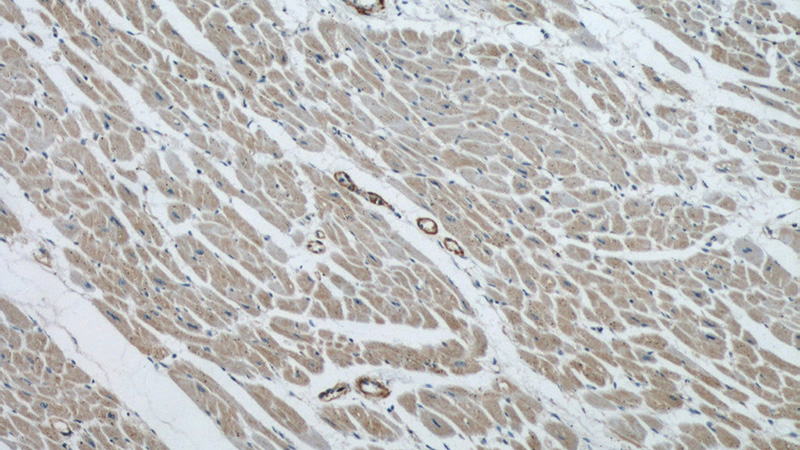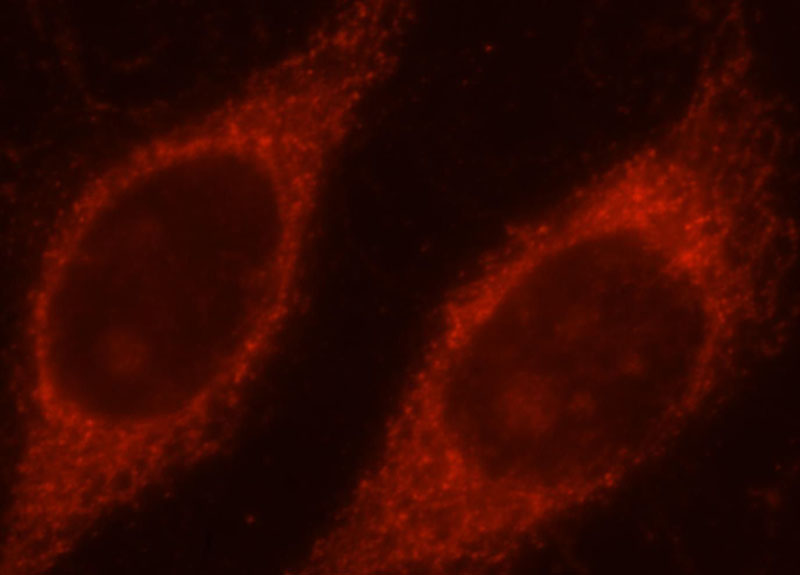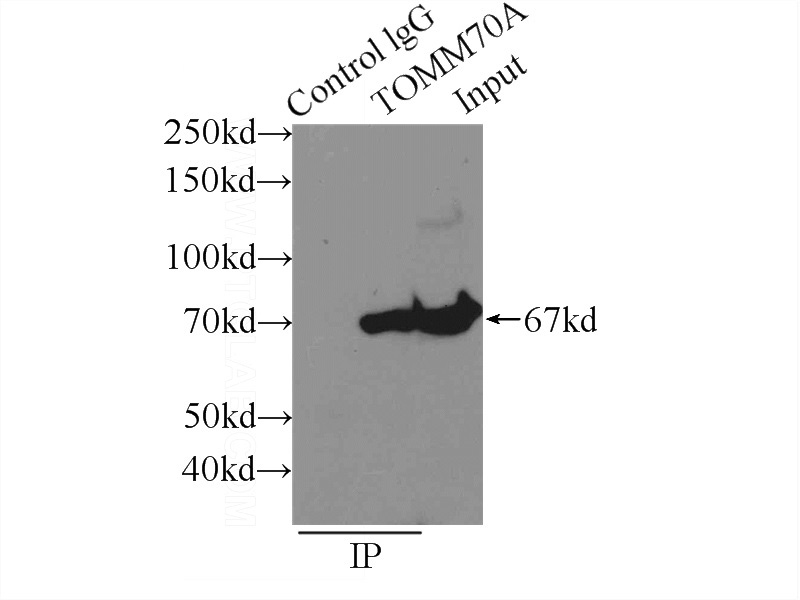-
Product Name
TOM70 antibody
- Documents
-
Description
TOM70 Rabbit Polyclonal antibody. Positive IF detected in Hela cells. Positive IHC detected in human heart tissue, human kidney tissue, human liver tissue. Positive FC detected in HeLa cells. Positive IP detected in mouse brain tissue. Positive WB detected in mouse liver tissue, MCF7 cells, mouse brain tissue, mouse heart tissue, mouse skeletal muscle tissue, rat heart tissue, rat skeletal muscle tissue. Observed molecular weight by Western-blot: 67kd
-
Tested applications
ELISA, IF, WB, IHC, IP, FC
-
Species reactivity
Human,Mouse,Rat; other species not tested.
-
Alternative names
TOM70 antibody; TOMM70A antibody
-
Isotype
Rabbit IgG
-
Preparation
This antibody was obtained by immunization of TOM70 recombinant protein (Accession Number: NM_014820). Purification method: Antigen affinity purified.
-
Clonality
Polyclonal
-
Formulation
PBS with 0.02% sodium azide and 50% glycerol pH 7.3.
-
Storage instructions
Store at -20℃. DO NOT ALIQUOT
-
Applications
Recommended Dilution:
WB: 1:500-1:5000
IP: 1:200-1:2000
IHC: 1:20-1:200
IF: 1:10-1:100
-
Validations

mouse liver tissue were subjected to SDS PAGE followed by western blot with Catalog No:116239(TOM70 antibody) at dilution of 1:1500

Immunohistochemical of paraffin-embedded human heart using Catalog No:116239(TOM70 antibody) at dilution of 1:50 (under 10x lens)

Immunohistochemical of paraffin-embedded human heart using Catalog No:116239(TOM70 antibody) at dilution of 1:50 (under 40x lens)

Immunofluorescent analysis of Hela cells, using TOMM70A antibody Catalog No:116239 at 1:25 dilution and Rhodamine-labeled goat anti-rabbit IgG (red).

IP Result of anti-TOM70 (IP:Catalog No:116239, 3ug; Detection:Catalog No:116239 1:500) with mouse brain tissue lysate 6000ug.

1X10^6 HeLa cells were stained with .2ug TOM70 antibody (Catalog No:116239, red) and control antibody (blue). Fixed with 90% MeOH blocked with 3% BSA (30 min). FITC-Goat anti-Rabbit IgG with dilution 1:100.
-
Background
TOMM70A (or TOM70) is a mitochondrial import receptor responsible for the import of cytosol synthesized precursor proteins into the mitochondria. Tom70 is a member of the tetratricopeptide repeat (TPR) co-chaperone family and contains a conserved TPR clamp domain for interaction with Hsc70 and Hsp90. Recently overexpression of TOM70 has been linked to chemoresistance to drugs in breast cancer cell lines. It is also believed that Tom70 is significantly associated with breast cancer relapse and may predict the recurrence of ovarian cancer.
-
References
- Sarraf SA, Raman M, Guarani-Pereira V. Landscape of the PARKIN-dependent ubiquitylome in response to mitochondrial depolarization. Nature. 496(7445):372-6. 2013.
- Bingol B, Tea JS, Phu L. The mitochondrial deubiquitinase USP30 opposes parkin-mediated mitophagy. Nature. 510(7505):370-5. 2014.
- Xu R, Hu Q, Ma Q, Liu C, Wang G. The protease Omi regulates mitochondrial biogenesis through the GSK3β/PGC-1α pathway. Cell death & disease. 5:e1373. 2014.
- Fiesel FC, Moussaud-Lamodière EL, Ando M, Springer W. A specific subset of E2 ubiquitin-conjugating enzymes regulate Parkin activation and mitophagy differently. Journal of cell science. 127(Pt 16):3488-504. 2014.
- Kazlauskaite A, Martínez-Torres RJ, Wilkie S. Binding to serine 65-phosphorylated ubiquitin primes Parkin for optimal PINK1-dependent phosphorylation and activation. EMBO reports. 16(8):939-54. 2015.
- Lam SS, Martell JD, Kamer KJ. Directed evolution of APEX2 for electron microscopy and proximity labeling. Nature methods. 12(1):51-4. 2015.
- Xu S, Cherok E, Das S. Mitochondrial E3 ubiquitin ligase MARCH5 controls mitochondrial fission and cell sensitivity to stress-induced apoptosis through regulation of MiD49 protein. Molecular biology of the cell. 27(2):349-59. 2016.
- Sin J, Andres AM, Taylor DJ. Mitophagy is required for mitochondrial biogenesis and myogenic differentiation of C2C12 myoblasts. Autophagy. 12(2):369-80. 2016.
Related Products / Services
Please note: All products are "FOR RESEARCH USE ONLY AND ARE NOT INTENDED FOR DIAGNOSTIC OR THERAPEUTIC USE"
